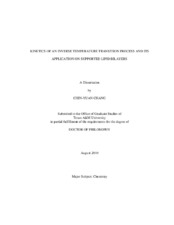| dc.contributor.advisor | Cremer, Paul S. | |
| dc.creator | Chang, Chin-Yuan | |
| dc.date.accessioned | 2011-10-21T22:03:05Z | |
| dc.date.accessioned | 2011-10-22T07:09:15Z | |
| dc.date.available | 2011-10-21T22:03:05Z | |
| dc.date.available | 2011-10-22T07:09:15Z | |
| dc.date.created | 2010-08 | |
| dc.date.issued | 2011-10-21 | |
| dc.date.submitted | August 2010 | |
| dc.identifier.uri | https://hdl.handle.net/1969.1/ETD-TAMU-2010-08-8358 | |
| dc.description.abstract | This dissertation focuses on the study of inverse temperature transition
processes of the poly(N-isopropylacrylamide) (PNIPAM) and the elastin-like
polypeptides (ELPs). A novel temperature jump microfluidic system is introduced and
this system shows the ability to measure the kinetics of the PNIPAM and the ELPs
collapse without a heat transfer problem. The conformational change of the ELPs during
the phase transition process is utilized as a nanoscale protein filter to modulate ligandreceptor
binding events on supported lipid bilayers (SLBs).
This research study is divided into three main parts. The first part is the
development of the temperature jump microfluidics. The kinetics of PNIPAM collapse is
used as a model system to show the capability of this new device to measure millisecond
time scale phase transition processes. The effects of salts on the kinetics of PNIPAM
collapse are also shown in this part. To our knowledge, this is the first study which
shows the effects of salts on PNIPAM collapse kinetics.
The second part of this research is the application of the novel temperature jump
microfluidics. The hydrophobic collapse of ELPs composed of identical sequence but
different chain length is investigated. By controlling the molecular weight of the ELPs, the thermodynamic contributions from intermolecular hydrophobic interactions, and
intramolecular hydrophobic interactions could be calculated individually for this unique
system.
The third part is the application of the phase transition property of ELPs. The
ELPs are conjugated on the surface of the SLBs as a nanoscale protein filter. The
conformation of the ELPs can be modulated by ionic strength of the buffer solution or
ambient temperature. The ELPs conjugated SLBs platform showed the ability to block
IgG binding to biotin conjugated on the SLBs when the ELPs were in the extended coil
state and open the access for protein to bind to biotin in compact globule conformation. | en |
| dc.format.mimetype | application/pdf | |
| dc.language.iso | en_US | |
| dc.subject | supported lipid bilayers | en |
| dc.subject | ELP | en |
| dc.subject | PNIPAM | en |
| dc.subject | microfluidics | en |
| dc.subject | polymer collapse | en |
| dc.title | Kinetics of an Inverse Temperature Transition Process and Its Application on Supported Lipid Bilayer | en |
| dc.type | Thesis | en |
| thesis.degree.department | Chemistry | en |
| thesis.degree.discipline | Chemistry | en |
| thesis.degree.grantor | Texas A&M University | en |
| thesis.degree.name | Doctor of Philosophy | en |
| thesis.degree.level | Doctoral | en |
| dc.contributor.committeeMember | Batteas, James D. | |
| dc.contributor.committeeMember | Scholtz, J. Martin | |
| dc.contributor.committeeMember | Schweikert, Emile | |
| dc.type.genre | thesis | en |
| dc.type.material | text | en |


